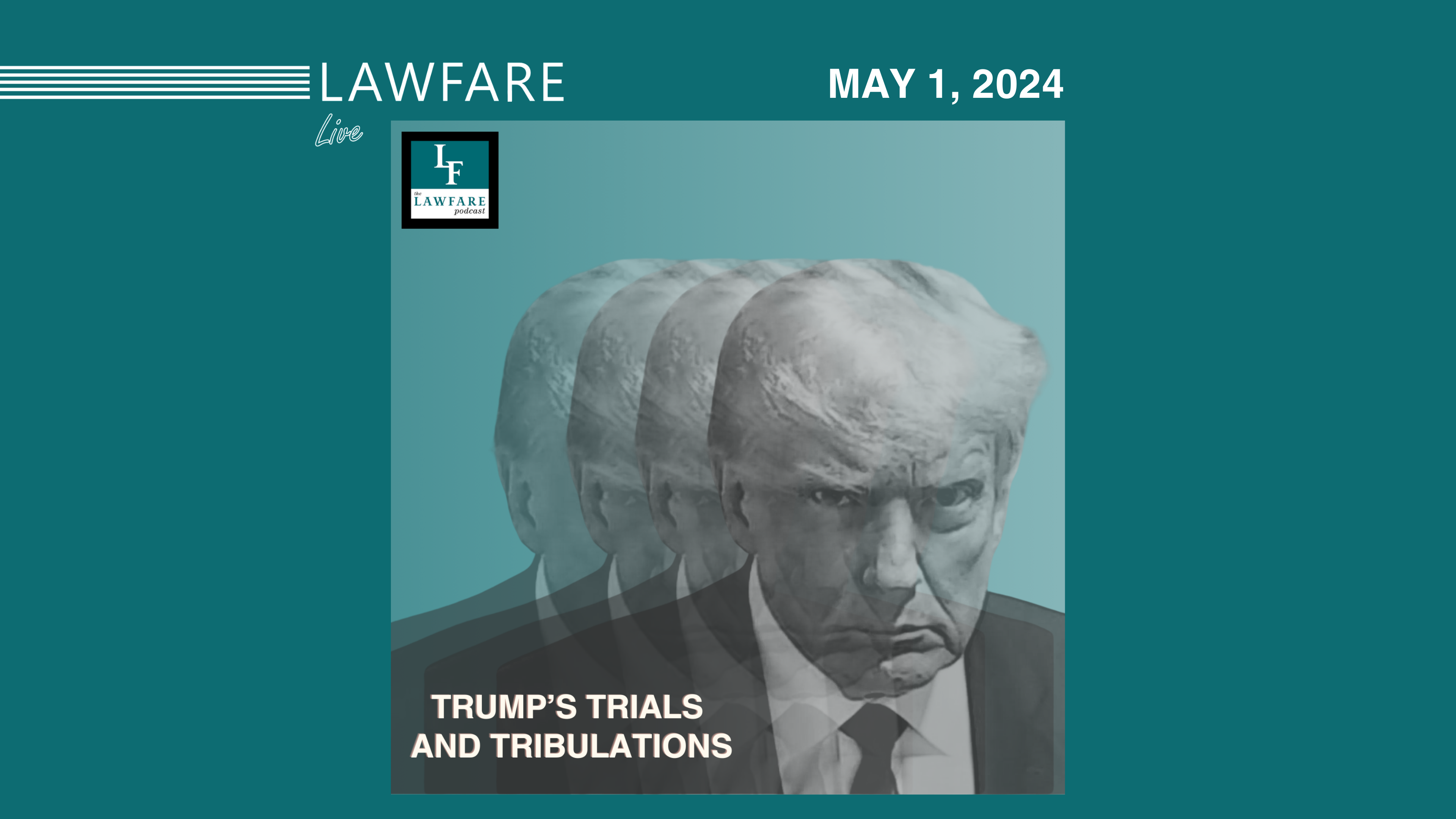Understanding Trump’s Invocation of the Defense Production Act for Meat
Why did problems in meat production lead the president to invoke a statute designed to preserve the nation’s security?

Published by The Lawfare Institute
in Cooperation With

Earlier this year, in the midst of meat processing plant closures due to a high incidence of coronavirus infections among workers, President Trump issued an executive order invoking the Defense Production Act (DPA) to prevent disruptions in the U.S. food supply chain caused by the pandemic. By invoking the DPA, the order effectively designated meat and poultry as products “essential to the national defense.”
For many Americans, thinking about food may be more likely to conjure up an image of a burger than concerns about national security. But a country’s security rests in part on the strength of its food supply chain. An abundance of food can lead a nation into a position of global legitimacy—and the absence of food can lead to a state’s downfall. For this reason, food is a fundamental pillar of national security considerations in the modern era. This context helps explain why problems in meat production led the president to invoke a statute designed to preserve the nation’s security.
What Is the Role of Food in National Security?
Generally speaking, food has taken on two roles in national security discourse: as a guardian of homeland security and as a weapon of war. While the connection between food and national security may be understood implicitly by U.S. lawmakers, the justification for this linkage requires an analysis of the part food has played in several major national security events from modern history.
History has shown us, perhaps most recently with the Arab Spring, that food insecurity, “a lack of consistent access to enough food,” can precipitate civil unrest. Though large-scale civil unrest is most likely to occur in countries with unstable political regimes, hunger drives people to “extreme and extraordinary behavior” as they fight to survive. When these behaviors turn violent, individual hunger on a mass scale often merits increased defense and military spending to respond to a threat that can rise to the regional, national or global level. Thus, starvation, in addition to its direct impact on civilian mortality rates, can be viewed as a national security threat.
In the U.S., hunger prevention has become an important part of the response to a national security event. For example, during World War I, the U.S.’s food supply chain came under stress when farmworkers were sent to fight overseas and European farmlands were turned into battlefields. Victory gardens emerged as a way for Americans back home to join in the war effort by contributing to the U.S. food supply. The idea was for Americans to grow food in idle spaces, such as backyards or fire escapes. Even children were invited to enlist as “soldiers of the soil” by joining the U.S. School Garden Army. The victory garden movement emerged again during World War II, when an estimated 20 million gardens provided nearly 40 percent of the nation’s fresh vegetables at one point.
Conversely, the national security implications of the need for food for survival is that cutting off the enemy’s food supply is a method of killing that poses little to no risk to the troops effectuating the “attack.” For example, the Nazi Hunger Plan plotted to use mass starvation as a tool to enable Germany to prevail in its occupation of the USSR—a region in which German troops were vastly outnumbered. However, history has shown that there are other ways food can be transformed into a weapon in the modern world, such as the U.S. and USSR’s “farms race”—a struggle to innovate and revolutionize their respective food production systems for maximum output as a symbol of legitimacy and industrial might during the Cold War.
Since the Sept. 11 attacks, the United States has recognized a new food-related national security threat: agroterrorism, defined by the Congressional Research Service as “the deliberate introduction of an animal or plant disease with the goal of generating fear, causing economic losses, and/or undermining social stability.” This threat is distinct from a starvation strategy because it focuses on intimidation and coercion rather than only effectuating civilian deaths. Since 9/11, the U.S. has more than tripled its appropriations for agriculture-related homeland security activities.
Why Did Meat Processing Plant Closures Threaten U.S. National Security?
The national security concerns surrounding the meat plant closures in April can be unambiguously understood in the category of food as a guardian of homeland security. The part that merits discussion, and concern, is why the closure of a few meat processing plants threatened to “break” the U.S. food supply chain. Consolidation of the U.S. food supply chain as well as a patchwork regulatory regime contributed to the heightened concerns over meat processing plant closures. These structural defects paved the way for executive involvement to avoid a food shortage at a scale rising to the level of a national security threat.
The U.S. has been plagued by aggressive consolidation at every level of the food supply chain over the past few decades. As a result, a smaller number of companies operate fewer and larger meatpacking facilities. For example, Tyson processes 16 percent of the nation’s pork in just six facilities. Tyson’s largest plant in Waterloo, Iowa, alone accounts for 5 percent of the nation’s pork supply, enough for consumers to notice meat shortages just days after the facility closed in response to a coronavirus outbreak. This consolidation has occurred on a geographic level as well, with Iowa being responsible for more than 30 percent of hog sales, increasing the threat that local disturbances pose to the U.S. food supply chain as a whole.
Because all parts of the food chain are connected, the effects of a shortage of one type of food can ripple across the food chain. For example, when pork production dropped, the demand for the grains used to feed swine plummeted. Further, a more extreme food category shortage can dramatically increase the demand for other products, raising prices at the consumer level across the board. The food supply chain is not well suited to adapt to market shocks because value chains are siloed into specialized categories, such as milk for schools or potatoes for restaurant french fries. This system prioritizes efficiency over flexibility, leaving producers unable to quickly redirect commodity ingredients to meet market demand. In the meat industry, producers were forced to euthanize animals that were designated to go to processing facilities that closed because there was nowhere to send them and feeding operations were experiencing extreme overcrowding. In this extreme display of market distortion, producers faced harsh financial losses and public outrage from having excess pork while consumers faced pork shortages.
When the coronavirus spread rapidly through the largest meat processing plants, primarily clustered in Iowa, pork production dropped 50 percent as facilities closed temporarily to control outbreaks. Though pork was significantly more impacted by the closures than other types of meat, the beef shortage across Wendy’s locations took the public spotlight. Perhaps because the burger has become a symbol of American patriotism, the inability to order a burger at some Wendy’s locations due to beef shortages sparked widespread public concern. When asked about the situation shortly after releasing the executive order, President Trump told the press that he would personally call the chairman of Wendy’s to resolve the issue. He then asked the secretary of agriculture if “everything is going to be good” in a week and a half. Unsatisfied with Secretary Sonny Perdue’s answer that plants would be opening over the next several weeks, Trump said, “You’re going to have to push them. Push them more.” In fact, the burger shortage may have been the impetus for the executive order, considering that Trump justified his use of the DPA with just one statistic: “[C]losure of a single large beef processing facility can result in the loss of over 10 million individual servings of beef in a single day.”
The structurally fragmented nature of the U.S. food governance system additionally contributed to the recent meat supply crisis by inhibiting both governmental response and oversight. At the federal level, 15 agencies participate in regulation and administration of the U.S. food system. Because the Department of Defense and Department of Homeland Security, two such agencies, participate only tangentially in the food system, there is no single agency nor mechanism to assess and respond to national security threats related to the food system. Congress has attempted to address some perceived national security issues touching the food system, but its approach thus far has been piecemeal, dealing with niche issues that can be administered through one or just a few agencies. This state of affairs makes it unlikely that the supply issues caused by the coronavirus would have been resolved without executive action.
The fragmented and overlapping authority of the federal agencies involved in food makes responding to an event that threatens the nation’s supply chain difficult. This difficulty manifested in the recent executive order itself, as the order, seemingly unintentionally, delegated authority to the Department of Agriculture (USDA) that would normally be under the Food and Drug Administration’s (FDA’s) jurisdiction. In response, the FDA and the USDA spent several weeks creating a memorandum of understanding in order to coordinate a response. Without such an agreement, the FDA and the USDA have no mechanism to coordinate a response to issues threatening the U.S. food supply.
The food system’s patchwork regulatory regime is at least partially responsible for plant closures in the first place. When the pandemic began, the Department of Homeland Security designated meat processing plants as essential, meaning they did not cease in-person operations with state stay-at-home orders. However, the Centers for Disease Control and Prevention (CDC) identified meat processing facilities as high-risk environments for spreading the coronavirus due to the small distance between workers on processing lines and in break areas, the long shifts standard to the industry, the common practice of shared transportation arrangements for workers, and the congregation of workers in small communities with ongoing community transmission.
Yet food supply workers are notoriously underprotected by U.S. labor laws due to special exemptions and overlapping agency authority. The Occupational Safety and Health Administration and the USDA both oversee worker safety in meat processing plants, and the division of labor between these two agencies is not clear. When the pandemic began, neither agency was equipped to provide adequate guidance on worker safety protocols for meat processing plants, and the CDC needed to be involved to respond to the threat of an airborne virus. Just two days before the executive order—weeks after plants began shutting down—the CDC and the Occupational Safety and Health Administration finally released joint interim guidance to assist employers in developing coronavirus control plans.
The meatpacking facility closures precipitated by the coronavirus pandemic are just one food-related event that has national security implications. But drawing from the broader context of food in national security considerations, there are many more ways in which this connection could manifest in the future. The “mystery seeds” received by Americans across the country this summer provided one such reminder that the U.S. food supply could be a strategic target. For now, the U.S. food supply chain seems to be holding up in the face of a pandemic, but whether it can withstand other national security threats is a question for the future.



-(1).png?sfvrsn=4fb01b27_3)

